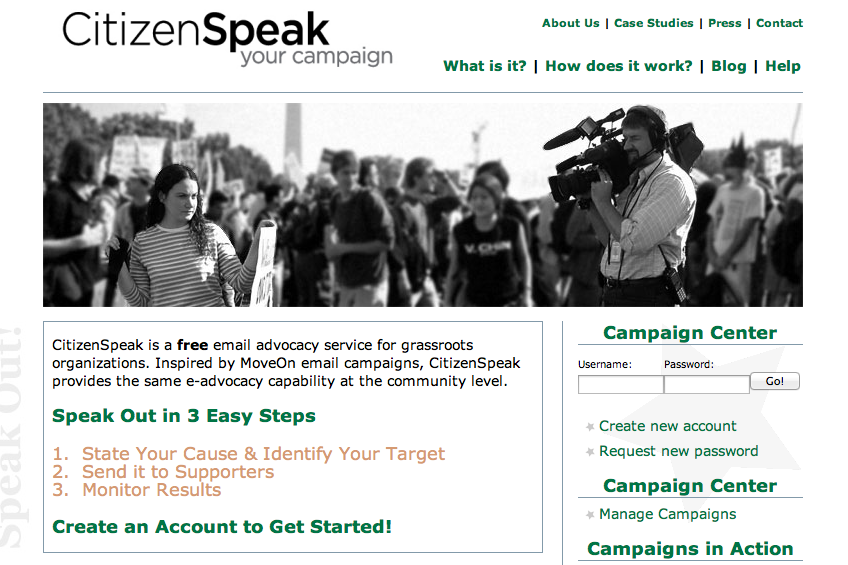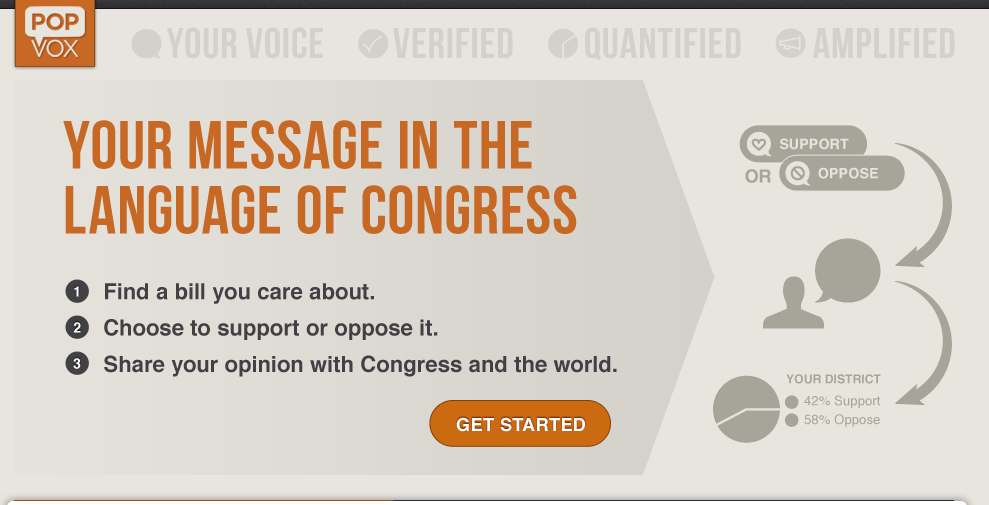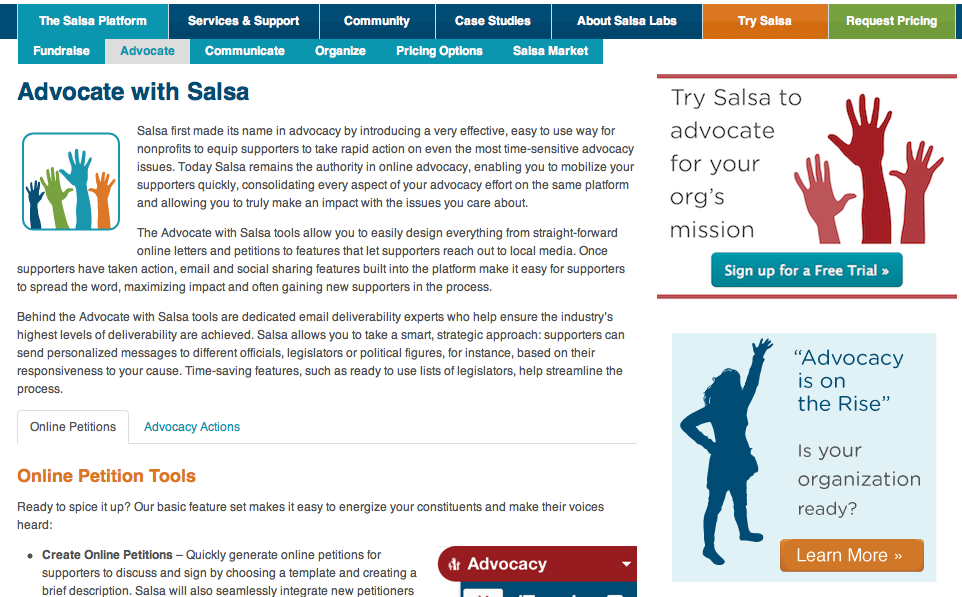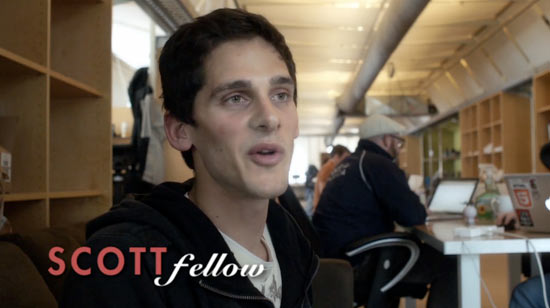The post Tools for e-advocacy: Resources for cause campaigns appeared first on Socialbrite.
]]>
Target audience: Advocacy and cause organizations, nonprofits, foundations, NGOs, social enterprises, political organizations, educators, journalists, general public.
Guest post by Kyle Henri Andre
Idealware
Advocacy organizations often encourage their grassroots supporters to influence politicians and corporations using different methods, from promoting a cause or opposing legislation to challenging ad campaigns or policies. A large display of public opinion can have a powerful message, and advocacy groups often help to focus and channel this support to make the most impact.
This has been traditionally done with mail. The sheer bulk of hundreds or thousands of letters was a strong visual stand-in for the people behind the cause. Today the tactic hasn’t changed, but the message is more likely to be delivered by email, telephone or social media, and the physical presence of the message replaced by the easy, constant barrage of communications.
Let’s look at a few of the tools available to help advocacy groups direct grassroots communications to a target.
Email-based tools
While once a strong alternative to physically mailing letters, high-volume email campaigns have become more difficult at the national level. Most Congressional offices now use web forms and other filters to restrict the flow of email to their inboxes, minimizing their impact. The majority of midrange and higher-end tools are able to navigate these roadblocks, but it’s a game of cat and mouse; as the email tools become more effective, so too do the defenses.
On the other hand, state and local politicians have lower email traffic and therefore tend to have fewer restrictions on the emails they receive. This makes them more effective targets. Corporations also tend to be more vulnerable to such efforts than Congress, and are more sensitive to attacks on their brand — and, in turn, more responsive to a campaign.
Web forms, filters and other obstacles do more than limit the volume of email that makes it to an inbox — they also request contact information. By requiring a street address, zip code or district, they make it possible to verify that the email is coming from a real person who’s a constituent of the targeted legislator. There’s growing concern among advocacy organizations that email is no longer the effective tool it once was, but a number of software applications can help with such campaigns.
Free and lower-cost tools

CitizenSpeak: The free tool CitizenSpeak provides a simple, straightforward method for advocacy organizations to create an email and then allow supporters to modify, personalize and send the message. Organizations must provide a single target email address, however, which makes it difficult to spread an email campaign across multiple voting districts. CitizenSpeak emails will not automatically navigate through web forms or other filters, making it better suited to a campaign targeting state or local politicians, or corporations.

POPVOX: POPVOX matches your supporters to their representatives and verifies them by name and address. Approved users can then support or oppose legislation by selecting from upcoming bills, or send messages to their representatives. (See our article PopVox: How to advocate your cause in Congress.)
For larger organizations

Salsa: Salsa offers email advocacy, list management, petition functionality, website content management features and survey capabilities. Email blasting and online donations are also available for additional fees. The package is quite flexible, and can be seamlessly integrated into a website, but you’ll need substantial HTML expertise to set it up. (See our article How Salsa Labs enables positive social action.)
For those with expansive needs and more substantial budgets, a number of high-end tools provide strong, advanced features — for a cost. These tools begin at around $1,000 per month. For instance, Blackbaud Sphere and Convio are fairly widely used among large advocacy organizations and combine advanced email advocacy capability with robust online features and constituent tracking. Several newer options from major advocacy consulting firms include ActionKit, put out by We Also Walk Dogs (which is closely associated with MoveOn.org), and a built-to-order offering by Blue State Digital.
Using your existing tools
If your targets aren’t hiding behind a filter or other roadblock, and you’re willing to get a little creative technically, you may be able to adapt one of the tools already used by your organization to send your message.
Most website Content Management Systems (CMSs) — like Drupal, Joomla, WordPress or Plone — provide the ability to create email website forms. You could pre-populate the form with the text of an email for supporters to modify or personalize, a method very similar to CitizenSpeak in functionality. This option has the advantage of being easily branded for your organization, and is fairly easy to implement. However, it relies on your CMS’s broadcast email functionality, which might be less reliable than other options included here.
If you’re running a national advocacy campaign, you might want to help your supporters to identify and contact their appropriate representative through your website. Cicero API, from Azavea, allows you to connect your supporters to their representatives when they enter their zip code. You’ll need a programmer to help you implement it.
Other campaign methods
Email is just one method being used to replace the traditional snail-mail campaigns. Telephone-based efforts and social media can both work well in different circumstances.
Click-to-call telephone tools
Congress has typically been more responsive to phone calls than emails, and staffers are more likely to answer a phone than reply to — or even read — an email. Technology is emerging that will allow your supporters to make a phone call by entering their phone number on your website and clicking a button. The tool will then call their phone to connect them with your campaign target. There’s no well-known software that’s available out-of-the box to provide this functionality, but consider Twilio if you’re able to work with a program to implement an application programming interface, or API, which is basically a way for websites to access data from another site.
Social media tools
As politicians and corporations have adopted social media, those channels have emerged as locations for advocacy campaigns. Social media channels like Facebook and Twitter are public locations that allow for more public exposure than calling or emailing a congressional office. Many national politicians seem to be embracing Twitter, in particular, and many national and multinational corporations and brands have similarly taken to both Twitter and Facebook.
Remember, because corporations have more at stake to protect the image of their brand, they are more likely to respond to campaigns. While your supporters can take action directly on Facebook, or using hashtags and retweets on Twitter, some purpose-built tools have emerged to help with these efforts. For instance, Act.ly provides a free tool that uses Twitter to target politicians and corporations.
Whatever method you use, advocacy campaigns can be an effective way to show the support for a particular piece of legislation or policy or a similar cause. There are enough different ways available to spread the message that it’s worth taking the time to choose the one that best fits both your supporters and your target.
To learn about different ways of conducting petitions and pledges online, read our article, A Few Good Online Petition Tools. To learn about advocacy in the age of social media, read Influencing Public Policy in the Digital Age: The Law of Online Lobbying and Election-Related Activities.
This article originally appeared on Idealware and is republished under a Creative Commons Attribution NonCommercial No Derivatives 2.5 license.
Related
• Social Advocacy Toolkit (Socialbrite)
• Resources for social advocates (Socialbrite)
• 10 top tools for cause campaigns (Socialbrite)
• E-campaign resources (Socialbrite)
• How Salsa Labs enables positive social action (Socialbrite)
• Crowdshout: Social advocacy made simple (Socialbrite)
• Growing nonprofits and social movements with NationBuilder (Socialbrite)
• Empowered.org: Out to grow grassroots movements (Socialbrite)
• Causes reinvents itself as a campaign center (Socialbrite)
The post Tools for e-advocacy: Resources for cause campaigns appeared first on Socialbrite.
]]>The post An engaging, uplifting nonprofit promo video appeared first on Socialbrite.
]]>Code for America from Inkerman Road on Vimeo.
Code for America: 5 tips on upping your video game
 Code for America, a nonprofit that uses technology to transform local governments, boasts a creative, compelling promotional video that not only clearly describes its message but also engages its viewers to get involved. In just five simple steps, any nonprofit can follow its example.
Code for America, a nonprofit that uses technology to transform local governments, boasts a creative, compelling promotional video that not only clearly describes its message but also engages its viewers to get involved. In just five simple steps, any nonprofit can follow its example.
Be human and personal
1Be sure to make a personal connection early in the video. Many organizations and causes have a cohort of motivated, smiling people behind it. Bring these people to the forefront and show how upbeat and promising working for the cause is! Code for America illustrates its work environment by interviewing employees about what part of the job and cause they like. People are human and social creatures and are more inclined to stick with a video if they can relate to the on-screen subjects.
Use captivating visuals
2Watching a talking head is no fun for anyone. But listening to someone speak while looking at colorful flowers or a fun work environment is far more interesting. The supplemental footage in a video that does not capture a talking head is called b-roll. For example, Code for America’s video displays a shot of the office while founder Jennifer Pahlka speaks over it.

Get creative with light
3The video’s lighting is bright and vibrant throughout. This, quite literally, illustrates Code for America’s cause in a positive light. For example, founder Jennifer Pahlka is interviewed outside, allowing her to be shot with the warmth of natural lighting. The creative use of silhouettes, close-ups and angles, by video producers Inkerman Road, provides a nice break from the traditional head and shoulders frame.

Keep it short — under 2 minutes
4The ideal length of a web video is under 2 minutes. People love video, but attention spans today are dreadfully short. This Code for America piece clocks in at 2 minutes 30 seconds. Wistia, a popular Web video hosting service, found that the completion rate for a 30 second video is close to 90 percent, but it drops to barely more than 50 percent if the video is 2 minutes. Of course, completion rate might not be critical, as long as viewers get the important bits of your message and are happy with your video. But if the call to action is in the last 10 seconds and no one watches that far, you have a problem. Which is why it’s a really good idea to front-load the video with the call to action and other critical message elements. Whatever you want the targeted audience to walk away knowing should be at the start of the video.
Instill optimism and hope
5Code for America does not focus on what the government is doing wrong, or why its services are necessary. That would lower the mood of viewers. Instead, the organization encourages people to take action by focusing on the future and how the combination of technology and government can improve lives, ending with a positive message: “Try helping your government work better for you and see what happens.”
Did you improve your video to make it more successful? Are you interested in learning how you could? Let us know if you’d like us to analyze your video.
 This work is licensed under a Creative Commons Attribution-NonCommercial 3.0 Unported.
This work is licensed under a Creative Commons Attribution-NonCommercial 3.0 Unported.
The post An engaging, uplifting nonprofit promo video appeared first on Socialbrite.
]]>The post PopVox: How to advocate your cause in Congress appeared first on Socialbrite.
]]>PopVox: Get through to Congress from JD Lasica on Vimeo.
Online service offers easy way to contact members of Congress on behalf of a cause
Target audience: Nonprofits, foundations, NGOs, social enterprises, cause organizations, businesses, Web publishers, educators, journalists, general public.
 One of our matras here at Socialbrite is that online actions only matter if they make a difference in the real world. So we spend a lot of time working with online advocacy organizations to assess the impact they make with their legislative or fundraising campaigns.
One of our matras here at Socialbrite is that online actions only matter if they make a difference in the real world. So we spend a lot of time working with online advocacy organizations to assess the impact they make with their legislative or fundraising campaigns.
One of the most effective tools to come along in recent years is PopVox, an online service that individuals and advocacy organizations can use to contact members of Congress on behalf of a cause.
With Congress returning from spring break today — with votes planned on the Buffett rule, gun bills and cybersecurity — it’s a good time to focus on what works, and doesn’t work, on Capitol Hill.
Marci Harris, founder and CEO of PopVox, founded the nonpartisan service based on her knowledge of how Congressional staffers interact with the public. As a former Congressional staffer, Marci said, “I was really frusteated with the way that information was coming into Congress.” She began keeping a long list of the ways that public input into legislation could be improved — and finally decided to do something about it herself.
Watch, embed or download the video on Vimeo
The most effective way to contact Congress
Being on the receiving end of the funnel, Marci said, “I have to tell you it’s too much. No staffer can possibly read every line that comes into a Congressional office.”
Professional advocates are good at mobilizing support for or against a particular bill. On the other hand, Marci said, “Grassroots advocacy is genuine and heartfelt and reflects the needs of real people across the country, but the asks that come in from people who are self-organizing are really unfocused — you know, save the environment, balance the budget, save the whales.” Congresspeople and their staffs can do little with such overtures.
“PopVox funnels these voices into very specific asks,” she said. On the site, a visitor has to choose a bill on a certain topic and support or oppose it as a first step. The site then works each day to make sure voters’ messages are delivered through something called Congressional Web forms. (There are about 541 different Congressional Web forms — a pipeline directly into Congress members’ offices.)
While an in-person visit or phone call from a constituent is still the best way to influence a member of Congress, that’s not always practicable. “Personalized messages are much better received than form letters or emails. Lowest on the list are form faxes — you might as well just throw those away.” Staffers don’t read those, she said.
Transparency is part of the PopVox formula. When you use the service, the public and news media can see the comments you send to members, “so it’s not just disappearing into the black box of a Congressional office,” she said. Citizens and advocates also have the option to share their cause, plea or rant via Facebook, Twitter and across the social Web.
A subscription-based version of PopVox gives advocacy organizations access to analytics and a rich dashboard. But for most social cause groups, the free version will do just fine.
A production note: Glitch in Adobe Premiere Elements 10
A production note: I recently bought Adobe Premiere Elements 10 and spent several weeks trying to produce this video. What I liked:
• The easy-to-use interface made it easy to add image stabilization (I didn’t bring a tripod), color correction and a brighter hue.
• But: the audio was out of sync, and a bug in Elements 10 on my Mac Pro prevented me from fixing this. So while it looked better, the out-of-sync audio ultimately forced me to scrap it after weeks of trying. And back to Final Cut Express I went.
Related
• Gov 2.0 resources: A directory from Socialbrite
 This work is licensed under a Creative Commons Attribution 3.0 Unported.
This work is licensed under a Creative Commons Attribution 3.0 Unported.
The post PopVox: How to advocate your cause in Congress appeared first on Socialbrite.
]]>The post Highlights from new report on online campaigns appeared first on Socialbrite.
]]>The report, titled “2009 eCampaigning Review Insights & Benchmarks,” was released this past week at an event in London (and via webcast). I want to share some of the highlights from the launch presentations of Duane Raymond and Jess Day, but if you want to skip ahead to the download, you can scroll to the bottom.
Report highlights
65% of actions reviewed in the report asked people to add their own message (whether this was a petition, or post, etc.). This is great because letting your supporters personalize or otherwise get more involved in your actions will only help build a commitment to the outcome of your campaign or action as well as encourage your supporters to ask their friends or colleagues to participate as well.
Only 43% of actions linked to background information. People may worry that if someone clicks on an action button, say, on your home page, and then you provide them links to more information about the topic of the action, that they will click away and never actually complete the action. Nope. People may want more background information but that’s because they are interested! Most all of the actions reviewed in the report that even those that did link to background information, those pages didn’t link back to the action. That’s why people aren’t completing the action. Remember to link to actions from everywhere on your site that is related to the action!
Resources or capacity are still an issue — the big organizations do better with online actions. This isn’t really a surprise as bigger organizations naturally have more people/staff and time, technical capacity and so on (many groups working on advocacy have only a couple people vs a large organization with hundreds).
58% of the actions scored full marks for visibility within their websites. That’s not a very high number for succeeding at visibility of actions on the one space online you have complete control: your own website. There are lots of places where actions could be included to be more visible, like the above note of including them on background information (or blog posts!).
11% of campaigns had no target (meaning, “join the campaign”). Be sure that if you are just trying to get supporters, or grow your list of interested people who could sign a petition or do other actions later on in your campaign or work, that you create an action that isn’t seen as empty or short term (literally just “we want your email”).
37% of the actions did not generate a thank you email after taking action; 74% sent poor quality thank you emails; and 69% do not send a follow up email within one month of a supporter taking action. This is bad news! After someone donates, signs up or completes any other action for your organization is prime time for providing relevant follow-up options to get more involved, learn more, or support your organization/campaign in other ways.
50% of organizations had databases that included 40% or more of inactive supporters. It doesn’t help your cause to have people in your database that aren’t really there. Provide ways for people to update their contact information or change their email address.
“If you stand back from the survey data these is one very clear message: strategic personalization and targeting are on a level of sophistication that many groups are still struggling to reach.” This means specifically working on segmenting your database and testing messages. Track your supporters’ actions to know who you should target for which actions and when. Succeeding at this, though, isn’t reliant on the tools but staff time and knowledge about how to do it.
Download reports
Visit the Advocacy Online website for more details and downloads.
- Advocacy Online summary document: download
![[PDF]](http://www.advocacyonline.net/images/xlink/xLink-pdf.gif)
- benchmark data (author: Duane Raymond): download
![[PDF]](http://www.advocacyonline.net/images/xlink/xLink-pdf.gif)
- e-action review (author: Jess Day): download
![[PDF]](http://www.advocacyonline.net/images/xlink/xLink-pdf.gif)
- e-campaigning survey (author: Jess Day): download
![[PDF]](http://www.advocacyonline.net/images/xlink/xLink-pdf.gif)
 This work is licensed under a Creative Commons Attribution-NonCommercial-ShareAlike 3.0 Unported.
This work is licensed under a Creative Commons Attribution-NonCommercial-ShareAlike 3.0 Unported.
The post Highlights from new report on online campaigns appeared first on Socialbrite.
]]>The post Mobile social marketing: How to do it right appeared first on Socialbrite.
]]>Of course, we think that advocacy organizations should start to pay serious attention to using mobiles in their work. There is increasing evidence that mobile social marketing works in increasing brand awareness and moving people to actions. It is also becming an increasingly effective way to engage users and constituents. Here are a few pointers from what we have learned to date.
1. What’s happening in the mobile (social) marketing market that advocacy organizations should pay attention to?
- Over 84 percent of Americans have cell phones, according to the CTIA, an industry group. Data shows that the majority of users carry their mobiles around for up to 18 hours/day. In fact the mobile, keys, and wallets are the three things most adults will not leave the house without.
- Sms/texting is growing by leaps and bounds. More than 48 billion text messages were sent in the month of December 2007, an average 1.6 billion messages per day. The rate of text messaging represented a 157 percent increase over December 2006 texting. (according to M:Metrics data)
- Mobile marketers are salivating, with polls, contests, coupons, and even mobi-sodes, short sms serial stories hitting the commercial market. Pepsi, Ford, Toyota, Burger King all have mobile campaigns, and more and more marketers are allocating hard dollars to “mobile marketing” budgets.
- Visa announced its mobile payment platform, allowing cardholders to use their mobile phones to make purchases or conduct other transactions by tapping them against readers. Think ‘just in time’ fundraising.
- There are pilot projects under way to test mobile fundraising via text message where the donation is billed to the customers monthly cell phone bill. Previously prohibitive because of carrier fees, the market for mobile fundraising is opening up this year. The carriers have agreed to waive fees for a set of pre-approved organizations vetted by the Mobile Giving Foundation that has just started operations. While small in scale so far, the mobile fundraising market is bound to rapidly expand in the next 12 months.
- More and more Americans have unlimited texting plans and WAP-enabled phones, allowing them to do more and more on their cell phones, including watching video and photos, browsing the web, and of course, ubiquitous text messaging. Social marketers now have at their disposal not only text campaigns, but can become more creative with multi-media, WAP push (clickable links to WAP-based multimedia content incorporated into SMS messages), and video shortcodes (consumers receive a video stream directly to their handset in response to texting to a shortcode).
- In fact, wireless subscribers sent more pictures and multimedia messages. Close to four billion multimedia messages (MMS) were sent in the second half of 2007. In all of 2006, a total of 2.7 billion MMS were sent, according to M:Metrics. Likewise, data services for all of 2007 totaled $23 billion, a 53 percent increase over 2006 when data revenue equaled $15.2 billion.
So, to sum it up: Why Mobile Phones for Advocacy?
The Internet has two distinct benefits over previous media – social interactivity and search. Mobile technology goes even further – not only can all elements of existing media be delivered via mobile, there are additional advantages of mobile that makes it far superior to other media forms. These include:
- There is a relatively low learning curve to using a phone, making it far more accessible than computers to a wider range of constituents.
- Mobiles are a highly personal means of communication that reaches the target constituent directly and immediately.
- They are hence conducive to instant participation and response.
- Mobiles are small and highly portable, and always-carried. Our mobile devices go with us everywhere.
- Always-on. Mobiles are always on and thus the ultimate news and alert media, faster than any other media.
- Donation and purchase channel. While not quite there yet in the U.S. mobile phones will eventually become wallets and payment systems.
- Hybrid communications tools with varied content and convergence with other media such as the Internet. Mobiles allow for texting, increasingly have multi-media support with built-in still and video cameras, can carry games, music, ringtones, and data.
- As such, mobile are media and creative devices. Users can increasingly create and share content from their cell phones.
But what’s the ROI for mobile marketers — such as advocacy organizations?
Everyone agrees: The medium is young, it is risky when poorly done, and it’ll take time to judge payoffs. Our research of existing campaigns shows some interesting returns with sizeable opt-ins, and rather impressive open and forward rates. The total numbers are still small but effect is beginning to show.
For example, an analysis of 26 research studies evaluates SMS campaigns in the U.K. Conclusions taken from the report, “Text Message Advertising: Dramatic Effect on Purchase Intentions:”
- “Overall 44% of respondents found receiving campaigns on their mobile phones very or fairly acceptable, with only 21% finding it fairly or very unacceptable.”
- “Acceptability was inversely related to respondents’ age (younger people have more favourable views; Chi-square, p<0.01), but not related to gender.”
- “Most messages were read (89%), and 5% were forwarded to friends.”
- “For most of the campaigns (20 out of 26), respondents followed the specified call to action, with the most frequent response following the message directions. These included calls to action involving physical travel (e.g. visit McDonald’s or the Carphone Warehouse).”
- “The overall acceptability of SMS advertising was 44%, significantly higher than the acceptability of telemarketing”
- “Response rates varied from 68% to 3%, with an average of 31%. This compares very favourably both with direct mail, with reported response rates between 1% and 5 %, (DMA, 2003; DMIS, 2000) and permission-based email marketing, with reported response rates from 1% to 8%, (Rettie, 2002; Doubleclick, 2002; Gartner, 2002).”
- “The reported increased likelihood to purchase is the most important finding of this research; on average this was 35%, but it was as high as 71% for one campaign.”
In the non-commercial realm, there is concrete evidence that text messaging gets people out to vote. In 2006, the Student PIRGs’ New Voters Project and Working Assets, two groups in the United States, worked with researchers from the University of Michigan and Princeton University to study the effectiveness of text messaging on voter turnout. The researchers sent text messages to young people reminding them to vote.
The methodology was sound: Researchers selected a random sample of 4,000 mobile phone numbers from 8,000 people who had registered to vote, and tested variations of different messages.
- Overall, they found that the text message reminders increased the likelihood that the voter would go to the polls.
- Text messages increased the chance that a person would vote by 4.2%
- 59% of voters surveyed found the messages helpful.
- 23% found the messages bothersome.
- Each additional vote generated cost $1.56; much cheaper than conventional methods like door-to-door campaigning or fliers.
Similarly, a study by Limbo, a mobile marketing company, evaluated ‘brand’ awareness of presidential candidates. The study included short ads (30-40 characters) on the bottom of text messages. The ads advertised U.S. presidential candidates. According to the study, 6% of respondents reported significant changes to their voting intentions and 22% said their voting intentions had been changed a little. The study found that:
- 6 % of those surveyed after the campaigns said that the advertising had changed their voting intentions significantly. This was highest for men at seven percent (7%), those aged 35+ at seven percent (7%), and for African Americans at nine percent (9%). An additional 22 percent (22%) said their intentions had been changed a little
- “Fourteen percent (14%) said that their perceptions of the candidate was now more positive than before seeing the campaign, with only four percent (4%) saying it was now more negative, a net 10 percent (10%) increase in positive perception. Barack Obama saw the biggest uplift, with a net gain of 16 percent (16%).”
- “Thirty-seven percent (37%) paid more attention to news coverage about the candidate.”
- “Twelve percent (12%) became more aware of other marketing for the candidate.
- “Seven percent (7%) visited the candidate’s website with a further 24 percent (24%) intending to do so in the future
- “Five percent (5%) visited the candidate’s mobile Internet site with a further nine percent (9%) intending to do so in the future.”
We have seen other positive effect as well, in the form of increased PR, for example. A clever campaign, especially one that goes viral, will get earned media coverage and word-of-mouth exposure.
What are advocacy organizations concerned about?
According to a recent article Brandweek, there still is considerable “consumer resistance, the main reason behind the carriers’ historic refusal to open the gates to ad content.” Brandweek goes on: “Studies have shown that consumers are less than thrilled with the idea of receiving ads on their cells. While early adopter teens are among the biggest targets, three-quarters of cell phone users ages 10 to 18 said they do not think it’s OK to be marketed to on a mobile device, according to a study of 2,000 users conducted by Weekly Reader Research, Stamford, Conn., on Brandweek’s behalf. Forrester Research in Cambridge, Mass., found 79% of consumers are turned off by the idea of ads on their phones and a mere 3% of respondents said they trust text ads.”
There are now strict guidelines, drafted by the Mobile Marketing Association, on opt-in and opt out procedures.
This means, of course, that advocacy organizations need to be scrupulous about their opt-in practices and absolutely meticulous in following the mobile marketing code of conduct. Organizations need to be aware that their brand is at stake, and people will get very annoyed if they perceive an organizations is spamming them.
Final word
People increasingly do not want to sink in the typical advocacy ‘push’ hole that benefits you organizationally, but in the end has no impact on the issue, nor engages me, the constituent, in any way, makes the issues relevant to my life, makes me smile, asks me to do something, or feel better and closer to the cause you are advocating.
In the end, because mobiles are an intimate medium, there is a huge opportunity for a conversation that few advocacy organizations used to messaging OUT have any idea how to do effectively. Mobiles are very much a read/write medium in the web 2.0 fashion and only those organizations willing to hear back and engage in ‘it’s the conversation, stupid’ will end up running catchy, creative, engaging, and innovative mobile campaigns.
For more use cases and idea, see MobileActive.org (search for advocacy in the search box for use cases).
Republished from MobileActive.org.
Related
• 20 tips for mobile advocacy (Socialbrite)
• A user’s guide to mobile activism (Socialbrite)
• How to set up an SMS campaign system (Socialbrite)
• 10 mobile apps for social good (Socialbrite)
 This work is licensed under a Creative Commons Attribution-NonCommercial-ShareAlike 3.0 Unported.
This work is licensed under a Creative Commons Attribution-NonCommercial-ShareAlike 3.0 Unported.
The post Mobile social marketing: How to do it right appeared first on Socialbrite.
]]>